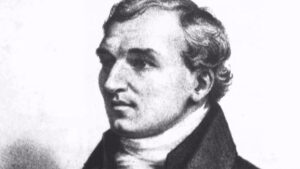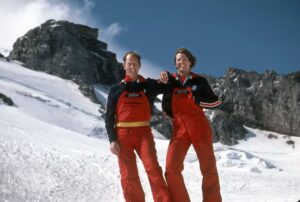To all appearances, the 800km expedition on a segment of the Churchill River in Saskatchewan was merely an adventure. Six men in three canoes launched from Ile-à-la-Crosse, paddling down the Churchill and then the Sturgeon Weir Rivers to Samuel Hearne’s Cumberland House. They were retracing one of many fur trading routes dating back to the 1600s. The 1955 trip, along with other expeditions into northern Canada, was led by conservation advocate and activist, Sigurd Olson.
Born in 1899, Olson had been a canoeist, wilderness guide, and outdoorsman since his teens. He first became involved in environmental activism in his 20s. His was a powerful voice in the preservation of the Quetico-Superior wilderness and Minnesota’s Boundary Waters Canoe Wilderness Area. In addition to working with the Izaac Walton League of America, the Wilderness Society, and the National Parks Association, Olson was an advisor to the National Park Service and to the Secretary of the Interior from 1959 to 1970. He also worked to establish the Arctic Wildlife Refuge, Point Reyes National Seashore, and Voyageurs National Park in Minnesota.

Bourgeois
His companions on the 1955 Churchill expedition included the Dutch ambassador to Canada, a Canadian Army Major General, the chairman of the Defense Research Board of Canada, the president of the Canadian Bank Note Company, and the executive director of an organization called the Associated Clubs of Canada. Despite their institutional career, all were experienced outdoorsmen and had canoed together previously. Every expedition needs someone in charge, and the fur traders of old designated their leader “Bourgeois.” Olson was voted commander of this trip and accordingly was dubbed Bourgeois.
Reading Olson’s account of the trip, The Lonely Land, one is immediately struck by the fact that the journey was as much about friendship and male bonding as it was about adventure. It is obvious that the success of the expedition, and other trips they took together, depended heavily on their skills and personalities and their seamless sharing of camp responsibilities, as well as their compatibility and camaraderie.
The Lonely Land describes encounters with tribal peoples, placid lakes, foul weather, insurmountable rapids, abundant fishing, spectacular scenery, and the odd prospector or backwoods priest.
Lake of the Dead
No trip into the wilderness is without danger. Some three hundred kilometers into their journey, the small band of voyageurs stood at Trout Lake Falls and looked downstream. Seven sets of rapids lay between them and the Lake of the Dead. The second set threw great surges of waves and backwash so strong the canoes were nearly engulfed.
Once on Lake of the Dead, a gale rose up with high rollers threatening safe passage across the 10km run to the eastern shore. A few islands held the promise of brief respite, but even there lay the risk of being dashed on the rocks. With a little luck and a good deal more skill, they made the crossing, covered two more sets of rapids, and settled in for the night at Otter Portage.

Ultimately, and unlike many prior travelers, the group fed no canoes to the rapids. They passed through wind and waves without capsizing. Aside from one member’s short battle with the flu or food poisoning, they avoided disease and injury.
Stolen by the dream people
The most unanticipated challenge they met was when a canoe was “stolen” by the wind or perhaps it was one of the Cree’s “dream people.” The Mamaygwessey have an apparently well-earned reputation as six-fingered, six-toed imps known for stealing canoes. Who or whatever the culprit, the canoe was recovered and the small band of voyageurs continued on their way.
The “Lonely” in the book’s title refers to the vast, sparsely populated nature of the north. Indigenous peoples have long known those lands for their beauty, dangers, and bountiful resources. But to the vast majority of immigrant adventurers, explorers, and other brave-hearted men and women driven to see what lay beyond the next ridge, the Lonely Land was a place to explore, to exploit, and ultimately, to exit.

Exploitation, as opposed to conservation, had been a thorn in Olson’s side since he was a young man, and his activism and environmental leadership was a consequence of that concern. The great value Olson placed on wilderness was entwined with his reverence for the outdoors.
The son of a Baptist minister, Olson became an evangelist for nature. The outdoors, he might well have preached, grants us spiritual gifts, if we but listen. Wilderness is “a spiritual necessity,” he wrote, “an antidote to the high pressure of modern life, a means of regaining serenity and equilibrium.”

The pursuit of stillness
Or, as he reflected in The Singing Wilderness, “the sun was trembling now on the edge of the ridge. It was alive, almost fluid and pulsating. As I watched it sink, I could feel the earth turning from it, actually feel its rotation. Over all was the silence of the wilderness, that sense of oneness that comes only when there are no distracting sights or sounds, when we listen with inward ears and see with inward eyes, when we feel and are aware with our entire beings rather than our senses. I thought as I sat there, ‘Be still and know I am God,’ and knew that without stillness there can be not knowing, we cannot know what spirit means.”
Olson pursued that stillness all his life. After living in several towns in Wisconsin and northern Minnesota, Olson and his wife Elizabeth moved to Ely, Minnesota in 1923 when he got a job teaching biology at the local high school. From there he taught, wrote, consulted, advocated, and canoed. By 1956, he found the demands of writing and conservation activism unrelenting. A man who knew the importance of and valued his solitude, Olson needed a retreat. He began construction on what was to become a modest cabin on a (then) relatively undeveloped point in Burntside Lake, just west of Ely.

Minimal footprint
Olson knew it was impossible to build a cabin in the wilderness without having an impact on the site: foundation materials and timber needed to be brought in, a latrine would need to be built, pathways carved through the brush. The decision to build was not one lightly made.
Rather than cut local timber, Olson purchased an abandoned chicken coop from a local farm, had it dismantled, and then, with a few modifications, re-assembled it as his one-room cabin. A small sauna was built first so that after a hard day’s labor, Olson and other workmen could relax and clean up. The latrine was tucked away in the woods, well away from the water’s edge.

Olson’s cabin today at Listening Point, near Ely, Minnesota. Photo: David Born
The cabin today
Today, his cabin contains several chairs, two single beds, and a fireplace, among other things. Overhead hangs a canoe and a few other mementos from Olson’s adventures: snowshoes, canoe paddles, a fishing pole. There is a blackened coffee can with a hard wire bail. (On one of their long trips Olson and friends had a canoe overturn in some rapids. The canoe and some gear were salvaged, but the cookware was gone. The coffee can served as their only pot and as a reminder that even the most experienced of us can fall prey to accidents.)
There is a small cooking area: a sink (water must be brought in from the lake or town), space for a small, camp-style stove, a cutting-board-sized counter for food prep, and a small table for dining. Outside, a small table for cleaning fish stands near the cabin. Disuse has summoned the elements to return the table to nature. In the meantime, it nourishes lichen, insects, and other forest beings.
Listening to the Earth
The highlight of the site for most visitors is the solitude. Individual visits aren’t permitted, but even in small, guided groups of eight or ten people, conversation is subdued and the clamor of daily life fades quickly. You can sit and contemplate the lake through a cabin window, hear the wind rustling the trees overhead, and sense the calm coming over you. Standing on the rocky shore, you can listen as the waves speak nature’s secrets. Listening to the Earth, after all, is what Olson was all about.
In 1958, he wrote:
I named this place Listening Point because only when one comes to
listen, only when one is aware and still, can things be seen and heard.
Everyone has a listening point somewhere. It does not have to be in the
north or close to the wilderness, but someplace of quiet where the
universe can be contemplated with awe.
Like Olson, I cherish those times when I can dip my paddle into the quiet waters of a northern river. Like him, my spirit sings of the “magic [to be found] in the feel of a paddle and the movement of a canoe, a magic compounded of distance, adventure, solitude, and peace. The way of a canoe is the way of the wilderness, and of a freedom almost forgotten.”






